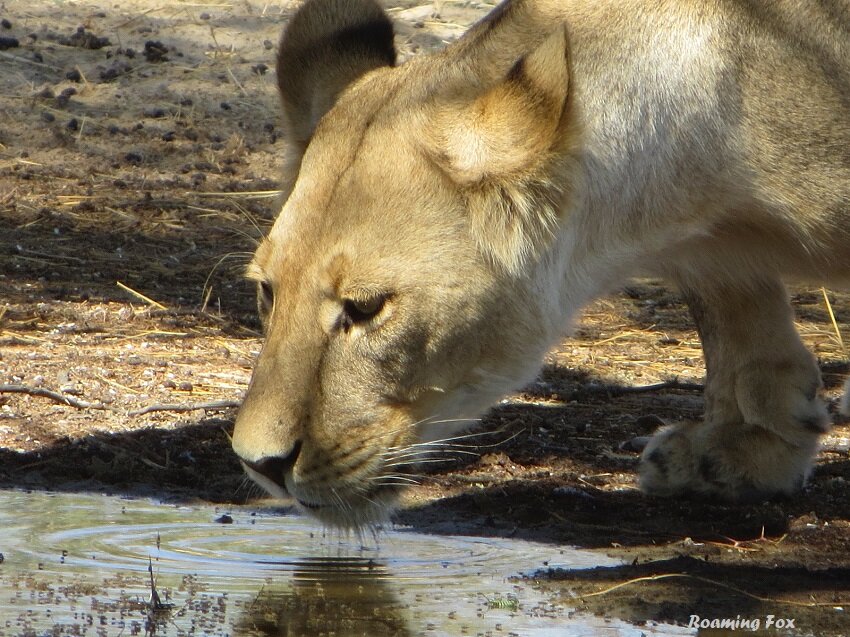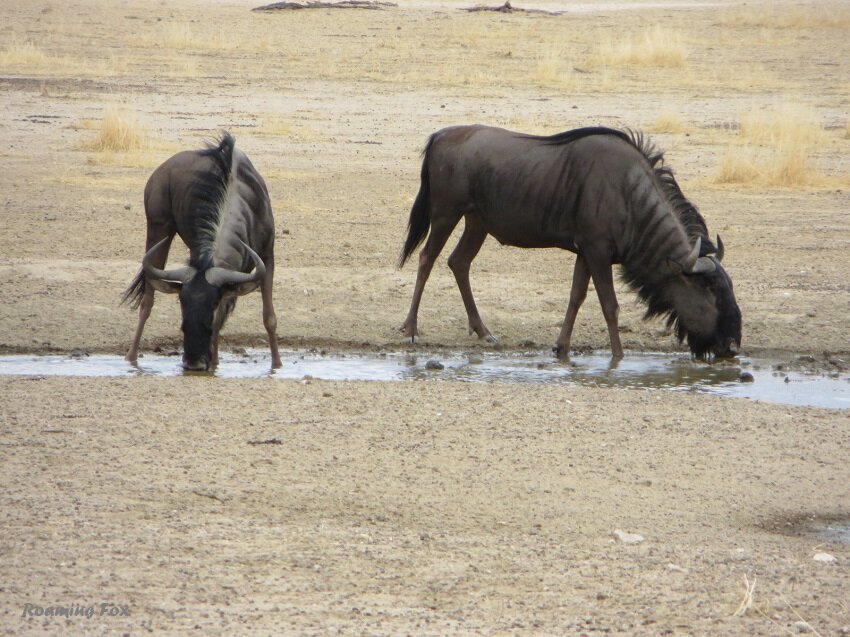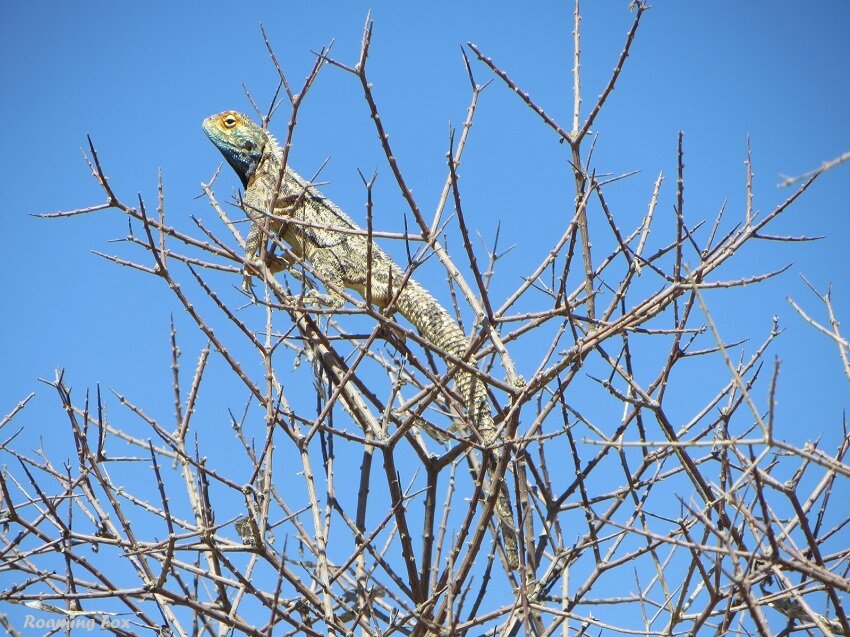Is Kgalagadi Transfrontier Park worth a visit?
Northern Cape – South Africa
Infinite red dunes, sparse vegetation and wildlife of Kgalagadi Transfrontier Park
Experience the Kalahari
After our recent trip to the Kgalagadi I have been reflecting. Is it really worth a visit? What makes this park so special that makes people return to it year after year, over a period of decades? Obviously it is for the animals and birds but is there something else? Being there has its challenges but there are rewards. Are they worthwhile?
With endless dunes rippling over 38 000 km² of the park, it is a wonder you see any game at all as they easily disappear over the horizon between South Africa and Botswana.
A dry riverbed and a dune in the Kgalagadi
Even giraffe look tiny although they are the largest animal in the park. In fact, two of the Big 5 are missing in this park as they would not survive - the elephant and the buffalo – so if you are looking for those you would be disappointed.
The unforgiving hardened land filled with dust and dotted with vegetation takes no prisoners. Day after day animals live to survive. Eat or be eaten. Everything happens in extremities. Riverbeds are dry most of the time with only boreholes filling the water holes. If the rivers do have water in after heavy rains, it is brief.
It is our third visit to the Kalahari. The sun beats down on the parched Kalahari sand as we drive in our vehicle, kept cool by the air conditioner. Thank goodness for that luxury. We see a shape in the landscape that looks different and slow down, endlessly scanning the area. Could that be a lion? No, it is only a tree stump.
Disappointed, we continue to a waterhole. Coming to a standstill with no tree in sight for shade, protocol is to turn off the engine while you look and wait. With the air conditioner off the car becomes an oven extremely quickly. We open our windows and the one sitting on the sunny side of the car suffers as the sun bakes down. Even well doused with sunscreen your skin scorches.
A few sandgrouse and Namaqua doves pluck up the courage and dare to drink water before a Lanner falcon can swoop down for its kill.
We sit for a while then brace ourselves to continue our pursuit on the corrugated roads, looking for the elusive big cats. There is a lot of bone jarring, teeth shattering and bosom bouncing discomfort. Our dashboard rattles in protest and our eyeballs are on the verge of popping out their sockets from all the vibrations, blurry with double vision.
Here and there we are rewarded with little scenes of wildlife scuttling around such as the four striped mice.
A swallow-tailed bee-eater glides into a hole in the sand on the verge of the road. A most inappropriate place for a nest.
A gemsbok (oryx) nibbles on a bone to absorb some calcium or any other meagre nutrients this bleached piece of skeleton has left to offer.
Cute owl chicks scrutinize us from a nest in the fork of a tree. One of the parents are not far away, keeping a beady eye on the paparazzi.
A Giant Eagle Owl looks at us steadily. With his years of wisdom living in the Kgalagadi what does he know that we don’t? Did you know their identification mark is the pink ‘eyeshadow’ above their eyes?
The Kgalagadi is known for its birds of prey. You will see many others ranging from tawny eagles, bateleurs, vultures, goshawks to Pygmy falcons.
A dust devil twirls from the sun-baked soil and reaches for the sky. Having been awake since 5 a.m. and driving around for a good few hours my eyelids are heavy and even the rough roads cannot keep me awake.
Just short of nodding off, our friends ahead of us stop in their tracks. We come to a standstill and I am instantly alert. There it is! Albeit not that close by, a leopard in a tree. He lifts his head periodically then has a snooze. We watch for a while, hoping he will move again. Alas, with no signs of him waking from his slumber eventually we drive back to camp.
The following day whilst driving the same route, two guys who we had met in the park a few days ago stop in the road, facing us. They gesticulate to our right. We gaze into the distance but cannot see anything. Then I see two ears sticking above the grass on the edge of the road, about two metres away from us.
This is like winning the lotto. A leopard so close but well camouflaged with his back to us. He strolls forwards, continuously inspecting the area for prey, then heads for a tree. Presumably the same leopard we saw the day before, he climbs up with ease, sits for a while and has a good look to see if he has a chance to hunt something down. Nothing interests him so he lies down and goes to sleep.
Big dilemma: should we stay in the hope that he moves or should we go? We wait for a while but decide to move on because it looks like he is there to stay. Not a bad sighting at all!
On an early game drive one morning we are fortunate to see a honey badger with two pale chanting goshawks following before they disappear over the dunes. A few minutes later we are greeted with another wonderful sight. A cheetah pair.
The best roadblock is of course a pride of lion lazing in the sun even though many of our acquaintances and friends categorically state that they don’t ‘do flat lion’. I agree it can be rather boring watching lions sleeping for a few hours but sometimes you are lucky and they move. For me it is enough of a thrill seeing them lying there, although I wouldn’t mind if they were a little bit more alert.
Kgalagadi roadblock
Fortunately this isn’t the only occasion we see lion. This male is protecting his campsite.
Another day we drive to a waterhole near Nossob and see nothing. In fact the water has a rather putrid smell. We hastily leave and continue on our drive. Upon return there is a pride of lion lazing in the shade. They keep us amused for a while. Another great closeup sighting in the Kalahari.
At camp life varies from laziness to some daily chores such as washing, cleaning and fixing those things that have rattled loose. The best part is chatting and catching up with our friends. The camaraderie is extended by making new ones as we walk around camp comparing our tent and caravan setups. We also compare notes with what we have seen and photos we have taken. Hopefully we will have more wow moments the next day.
Sipping sundowners we watch the sun set on the horizon. As dusk settles into night glittering stars come to life one by one until a black velvet sky is bedecked with shimmering diamonds. The clarity is unbelievable. Our entertainment for the night is watching satellites and the ISS orbit the earth. What more can one ask for?
What I don’t like about the Kgalagadi
One spends hours driving in the hope of that special moment. Sometimes you are lucky, sometimes not. You might miss something and the vehicle behind you has the best sighting of their lives in the Kgalagadi. That is just the luck of the draw.
Dramatic dust and thunderstorms that the Kgalagadi is renowned for, accompanied by strong winds is par for the course. Whilst interesting to watch being sandblasted with grit in your eyes is not fun. Tents collapse and some even tear. Some campers leave their coals burning which can do serious damage in and out of camp when they blow horizontally at speed.
The scorching summer temperatures during the day of at least 37 degrees Celsius can be quite unbearable.
Driving for hours on roads that vary from fairly good to atrocious is quite grueling. It is said that the roads keep the run of the mill tourist at bay, but it takes its toll on your vehicle and/or your caravan or trailer. Although they scrape the roads regularly it is short-lived.
Not many people come out unscathed from the Kgalagadi Transfrontier Park. We were luckier this time. Apart from our number plate coming loose, milk and yoghurt cartons leaking even with some extra padding, a couple of eggs cracked and scrambled before I even had a chance to cook them and a beer can rubbing through, we cannot complain.
The toilet facilities situated at picnic spots are few and far between when on a game drive. One needs a strong bladder and it is vital to keep your fluids up in the heat, but then one could have an issue…
It is snake and scorpion territory. You have to be careful when you shake out your ground sheet or tent. It is also wise to shake out your shoes before putting them on because scorpions are known to creep into dark cracks and holes.
Hot Tip:
It is worth taking a few tools, a puncture repair kit, some duct tape and a medical aid kit and maybe a few extras. It is also a good idea to check your vehicle and equipment regularly, for instance for loose nuts and bolts.
Red hartebeest
Do you need a 4x4 in the Kgalagadi?
The paragraph above begs the question, do you need a 4x4 in the Kgalagadi. It is not essential in the South African part of the park, as long as you are not going over the dunes to some of the wilderness camps. However it is highly recommended, even by SANPARKS and they advise you to deflate your tyres too.
Please heed this as it preserves the roads for just a little bit longer. All three of the main camp sites have fuel stations with air where you can repump your tyres when you need to.
There are areas with soft sand where an inexperienced driver can get stuck. On all of our visits we have seen vehicles break down for various reasons.
“SANPARKS Tips and Advice
A 4x4 with high ground clearance and low range capabilities is recommended.
Kindly note that the roads in the Kgalagadi are not sedan friendly and that sedan vehicles find it difficult to cope with the road conditions and that some roads might not be accessible when wet, although management intervenes to maintain the roads on a regular basis.
The main camps do have drinking water albeit very mineralised. The Wilderness camps do not have potable water and one should provide their own drinking water.
Temperatures vary greatly from -11°C on cold winter nights to 42°C in the shade on summer days when the ground surface temperature reaches a sizzling 70°C. During the winter months, when frost is common, the ground surface temperature can be 25°C lower that the temperature of the air. Winter in the Kalahari is a cool, dry season from September to October and then a hot, wet season from November to April.
Shoes are essential on summer evenings for protection against the possibility of scorpion stings.
Keep an emergency supply of 10 litres water in your vehicle.
In the event of a breakdown, remain in your vehicle – it is the safest place.
Roads in the park have gravel surfaces. In other words, there are no tarred roads.
The travelling time from the entrance gate at Twee Rivieren to Nossob Rest Camp is 4.5 hours and to Mata Mata is 3.5 hours. When driving from one rest camp to the other, travellers should depart with travelling times in mind to ensure arrival before sunset as no travelling is allowed in the park after dark.”
Preparation for the Kgalagadi
There is a great deal of preparation when planning to spend time in the Kgalagadi Transfrontier Park, whether it be the milder South African side or the wilder Botswana side. We have done both so be sure to take a look at my other blogs for some tips, information and inspiration. All three of the main camps, Twee Rivieren, Mata Mata and Nossob have well stocked shops with some basic supplies as well as water, wood and charcoal.
Photography in the Kgalagadi
We had some very good sightings in the Kgalagadi otherwise known as the Kalahari. Although most certainly not Photographer of the year footage, my memory shot photos will give you an idea what you can experience in the Kgalagadi.
Taking photos in the Kgalagadi is no easy task. My poor little Canon Power Shot, whilst a brilliant camera and just the right size for me, just isn’t up to the task. Impressive lenses (complete with great photographers) are far better equipped for vast open spaces and animals ready to hide behind the sandy dunes.
The haze from the heat and the harsh light also makes it difficult to photograph at times so some of the best shots are early morning. Late afternoon is generally the hottest part of the day.
Now that you’ve read this blog, I will let you decide if it is worth going to the Kgalagadi, even if it is only once, never mind three times. What do you think?
Related blog posts:
What you need to know about Kgalagadi Transfrontier Park
What you can experience in the Kgalagadi
How to prepare for off the grid camping in Kgalagadi – Botswana
Itinerary and route to Kgalagadi Transfrontier Park
High jinks of a jackal at Rooiputs campsite Kgalagadi Botswana
Why it is worth spending time at Polentswa waterhole
How to be on high alert for predators at Polentswa Kgalagadi
Find me on Social Media
Kgalagadi Blogs - South Africa & Botswana
If you would like to leave a comment on my blog, at the end click Subscribe via e-mail to have your say and to receive email notifications of my reply or others regarding that post. Visitors must be logged in to subscribe and this will subscribe visitors to the comment thread, but not my entire blog. I know it’s quite a process, but it helps keep our websites secure. Your email address will not be shared or displayed.
Alternatively, you can comment as a guest without logging in, but you will not be notified of my answer.
Regarding comments, if my comments section is not working properly please send a comment via email. Thank you! Email: rmngfox@gmail.com

















































After our recent trip to the Kgalagadi I have been reflecting. Is it really worth a visit?